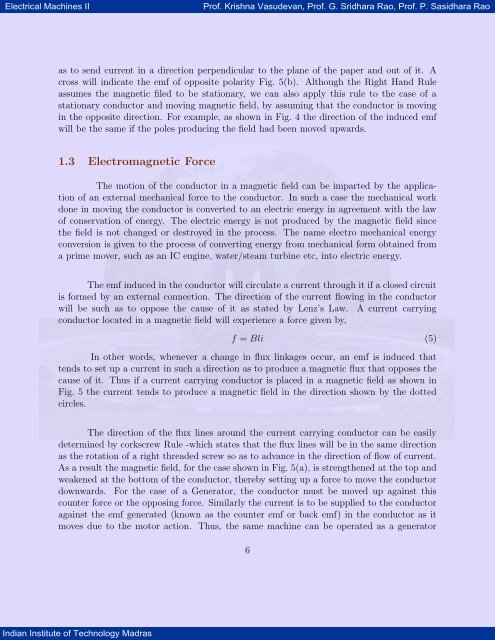Synchronous Machines - E-Courses
Synchronous Machines - E-Courses
Synchronous Machines - E-Courses
Create successful ePaper yourself
Turn your PDF publications into a flip-book with our unique Google optimized e-Paper software.
Electrical <strong>Machines</strong> II Prof. Krishna Vasudevan, Prof. G. Sridhara Rao, Prof. P. Sasidhara Rao<br />
as to send current in a direction perpendicular to the plane of the paper and out of it. A<br />
cross will indicate the emf of opposite polarity Fig. 5(b). Although the Right Hand Rule<br />
assumes the magnetic filed to be stationary, we can also apply this rule to the case of a<br />
stationary conductor and moving magnetic field, by assuming that the conductor is moving<br />
in the opposite direction. For example, as shown in Fig. 4 the direction of the induced emf<br />
will be the same if the poles producing the field had been moved upwards.<br />
1.3 Electromagnetic Force<br />
The motion of the conductor in a magnetic field can be imparted by the application<br />
of an external mechanical force to the conductor. In such a case the mechanical work<br />
done in moving the conductor is converted to an electric energy in agreement with the law<br />
of conservation of energy. The electric energy is not produced by the magnetic field since<br />
the field is not changed or destroyed in the process. The name electro mechanical energy<br />
conversion is given to the process of converting energy from mechanical form obtained from<br />
a prime mover, such as an IC engine, water/steam turbine etc, into electric energy.<br />
The emf induced in the conductor will circulate a current through it if a closed circuit<br />
is formed by an external connection. The direction of the current flowing in the conductor<br />
will be such as to oppose the cause of it as stated by Lenz’s Law. A current carrying<br />
conductor located in a magnetic field will experience a force given by,<br />
Indian Institute of Technology Madras<br />
f = Bli (5)<br />
In other words, whenever a change in flux linkages occur, an emf is induced that<br />
tends to set up a current in such a direction as to produce a magnetic flux that opposes the<br />
cause of it. Thus if a current carrying conductor is placed in a magnetic field as shown in<br />
Fig. 5 the current tends to produce a magnetic field in the direction shown by the dotted<br />
circles.<br />
The direction of the flux lines around the current carrying conductor can be easily<br />
determined by corkscrew Rule -which states that the flux lines will be in the same direction<br />
as the rotation of a right threaded screw so as to advance in the direction of flow of current.<br />
As a result the magnetic field, for the case shown in Fig. 5(a), is strengthened at the top and<br />
weakened at the bottom of the conductor, thereby setting up a force to move the conductor<br />
downwards. For the case of a Generator, the conductor must be moved up against this<br />
counter force or the opposing force. Similarly the current is to be supplied to the conductor<br />
against the emf generated (known as the counter emf or back emf) in the conductor as it<br />
moves due to the motor action. Thus, the same machine can be operated as a generator<br />
6

















